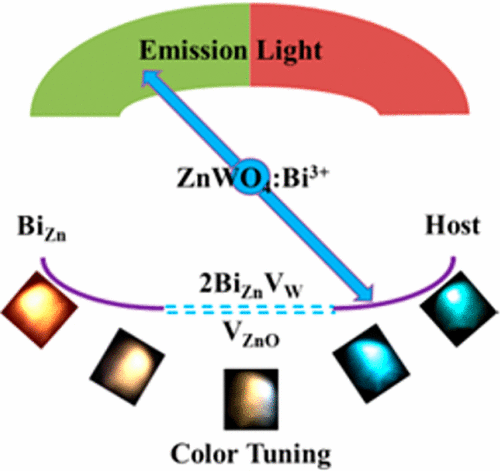当前位置:
X-MOL 学术
›
Chem. Mater.
›
论文详情
Our official English website, www.x-mol.net, welcomes your
feedback! (Note: you will need to create a separate account there.)
Toward Bi3+ Red Luminescence with No Visible Reabsorption through Manageable Energy Interaction and Crystal Defect Modulation in Single Bi3+-Doped ZnWO4 Crystal
Chemistry of Materials ( IF 7.2 ) Pub Date : 2017-09-19 00:00:00 , DOI: 10.1021/acs.chemmater.7b02979 Jin Han 1 , Lejing Li 1 , Mingying Peng 1 , Bolong Huang 2 , Fengjuan Pan 3 , Fengwen Kang 2 , Liyi Li 1 , Jing Wang 4 , Bingfu Lei 5
Chemistry of Materials ( IF 7.2 ) Pub Date : 2017-09-19 00:00:00 , DOI: 10.1021/acs.chemmater.7b02979 Jin Han 1 , Lejing Li 1 , Mingying Peng 1 , Bolong Huang 2 , Fengjuan Pan 3 , Fengwen Kang 2 , Liyi Li 1 , Jing Wang 4 , Bingfu Lei 5
Affiliation

|
The last decades have witnessed the discovery of tens of thousands of rare earth (RE) (e.g., Eu2+) and non-RE (e.g., Mn2+) doped photonic materials for near-ultraviolet (NUV) and blue converted white light-emitting diodes (wLEDs), but the future development of wLEDs technology is limited greatly by the intrinsic problems of these traditional dopants, such as the insurmountable visible light reabsorption, the weak absorption strength in NUV or blue region, and so on. Here we report a feasible strategy guided by density functional theory (DFT) calculation to discover novel Bi3+ red luminescent materials, which can solve the above problems eventually. Once the untraditional ion of bismuth is doped into ZnWO4 crystal, multiple defects can be possibly created in different charge states such as BiZn, BiW, interstitial Bi, and even defect complexes of 2 BiZnVW among others, and they, as DFT calculated results illustrate, have the potential to produce emission spanning from visible to near-infrared. As confirmed by experiment, tunable emission can be led to cover from 400 to 800 nm after controls over temperatures, defect site-selective excitation schemes, and the energy transfer between these defects and host. A novel red luminescence was observed peaking at ∼665 nm with a broad excitation in the range of 380–420 nm and no visible absorption, which is evidenced by the temperature-dependent excitation spectra and the diffuse reflection spectra. DFT calculation on defect formation energy shows that BiZn3+, the valence state of which is identified by X-ray photoelectron spectroscopy, is the most preferentially formed and stable defect inside a single Bi-doped ZnWO4 crystal, and it produces the anomalous red luminescence as confirmed by the single-particle level calculations. Calculation based on dielectric chemical bond theory reveals that the high covalency of the lattice site which Bi3+ prefers to occupy in ZnWO4 is the reason why the emission appears at longer wavelength than the previously reported compounds. On the basis of this work, we believe that future combination of DFT calculation and dielectric chemical bond theory calculation can guide us to efficiently find new phosphors where Bi3+ can survive and emit red light upon NUV excitation. In addition, the DFT calculation on Bi defects in different charge states will help better understand the longstanding as yet unsolved problem on the mechanism of NIR luminescence in bismuth-doped laser materials.
中文翻译:

通过可控的能量相互作用和单Bi 3+掺杂的ZnWO 4晶体中的缺陷控制,实现Bi 3+红色发光而无可见的重吸收。
在过去的几十年中,发现了成千上万的稀土(RE)(例如Eu 2+)和非RE(例如Mn 2+)掺杂的用于近紫外(NUV)和蓝色转换白光的光子材料的发现。发光二极管(wLED),但是wLED技术的未来发展受到这些传统掺杂剂固有的问题的极大限制,例如无法克服的可见光重吸收,在NUV或蓝色区域的吸收强度弱等。在这里,我们报告了一种以密度泛函理论(DFT)计算为指导的可行策略,以发现新颖的Bi 3+红色发光材料,最终可以解决上述问题。一旦铋的非传统离子被掺杂到ZnWO 4中晶体,可能会在不同的电荷状态下产生多个缺陷,例如Bi Zn,Bi W,间隙Bi甚至2 Bi Zn V W的缺陷配合物正如DFT计算结果所示,它们具有产生从可见光到近红外的发射范围的潜力。正如实验所证实的,在控制温度,缺陷部位选择性激发方案以及这些缺陷与主体之间的能量转移之后,可调发射可以覆盖400至800 nm。观察到一种新颖的红色发光峰在约665 nm处达到峰值,在380-420 nm范围内有宽激发,没有可见吸收,这是由与温度有关的激发光谱和漫反射光谱所证实的。缺陷形成能的DFT计算表明Bi Zn 3+X射线光电子能谱鉴定的价态是在单个Bi掺杂ZnWO 4晶体中最优先形成且最稳定的缺陷,并且通过单粒子能级计算可以确认其产生了异常的红色发光。基于介电化学键理论的计算表明,Bi 3+倾向于在ZnWO 4中占据较高的晶格位置,这是发射出现在比以前报道的化合物更长的波长处的原因。根据这项工作,我们相信DFT计算和介电化学键理论计算的未来结合可以指导我们有效地找到Bi 3+可以在NUV激发下幸存并发出红光。此外,对不同电荷状态的Bi缺陷进行DFT计算将有助于更好地理解掺铋激光材料中NIR发光机理的长期存在的问题。
更新日期:2017-09-20
中文翻译:

通过可控的能量相互作用和单Bi 3+掺杂的ZnWO 4晶体中的缺陷控制,实现Bi 3+红色发光而无可见的重吸收。
在过去的几十年中,发现了成千上万的稀土(RE)(例如Eu 2+)和非RE(例如Mn 2+)掺杂的用于近紫外(NUV)和蓝色转换白光的光子材料的发现。发光二极管(wLED),但是wLED技术的未来发展受到这些传统掺杂剂固有的问题的极大限制,例如无法克服的可见光重吸收,在NUV或蓝色区域的吸收强度弱等。在这里,我们报告了一种以密度泛函理论(DFT)计算为指导的可行策略,以发现新颖的Bi 3+红色发光材料,最终可以解决上述问题。一旦铋的非传统离子被掺杂到ZnWO 4中晶体,可能会在不同的电荷状态下产生多个缺陷,例如Bi Zn,Bi W,间隙Bi甚至2 Bi Zn V W的缺陷配合物正如DFT计算结果所示,它们具有产生从可见光到近红外的发射范围的潜力。正如实验所证实的,在控制温度,缺陷部位选择性激发方案以及这些缺陷与主体之间的能量转移之后,可调发射可以覆盖400至800 nm。观察到一种新颖的红色发光峰在约665 nm处达到峰值,在380-420 nm范围内有宽激发,没有可见吸收,这是由与温度有关的激发光谱和漫反射光谱所证实的。缺陷形成能的DFT计算表明Bi Zn 3+X射线光电子能谱鉴定的价态是在单个Bi掺杂ZnWO 4晶体中最优先形成且最稳定的缺陷,并且通过单粒子能级计算可以确认其产生了异常的红色发光。基于介电化学键理论的计算表明,Bi 3+倾向于在ZnWO 4中占据较高的晶格位置,这是发射出现在比以前报道的化合物更长的波长处的原因。根据这项工作,我们相信DFT计算和介电化学键理论计算的未来结合可以指导我们有效地找到Bi 3+可以在NUV激发下幸存并发出红光。此外,对不同电荷状态的Bi缺陷进行DFT计算将有助于更好地理解掺铋激光材料中NIR发光机理的长期存在的问题。











































 京公网安备 11010802027423号
京公网安备 11010802027423号